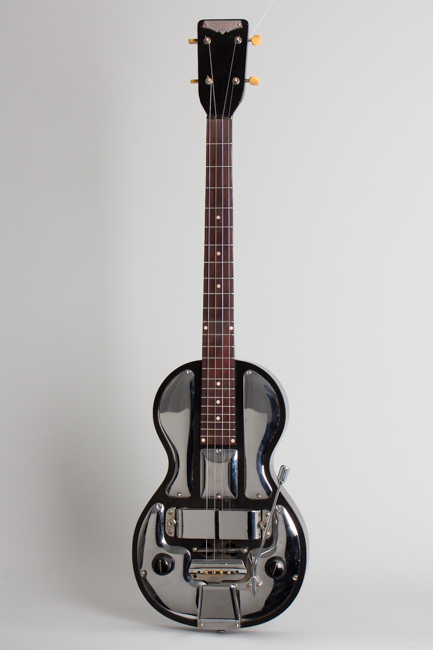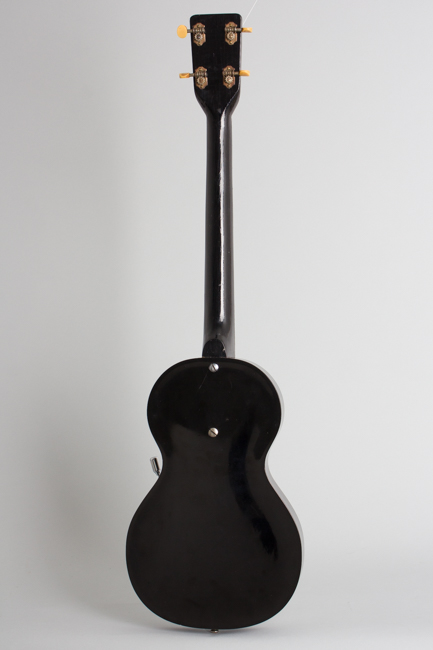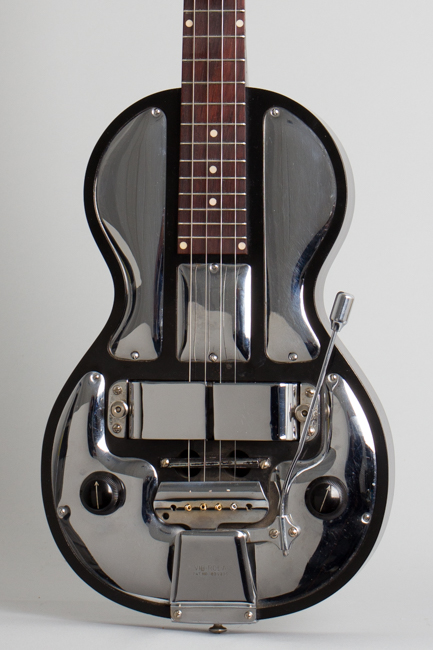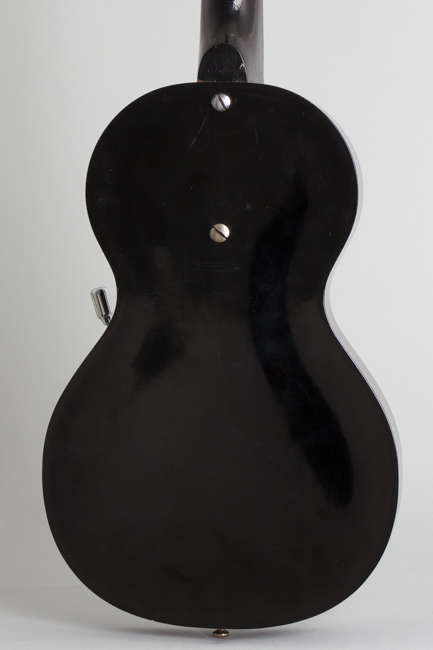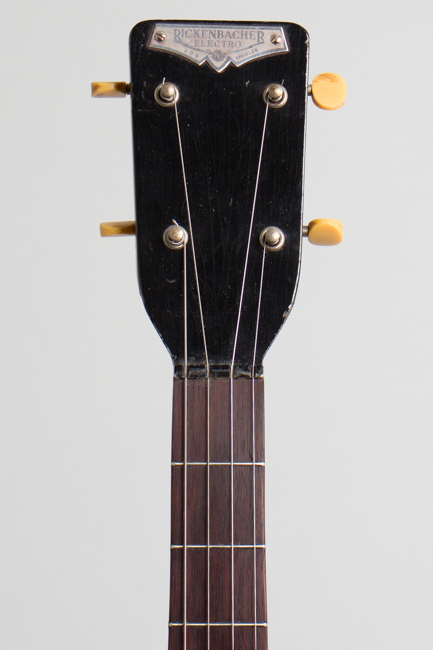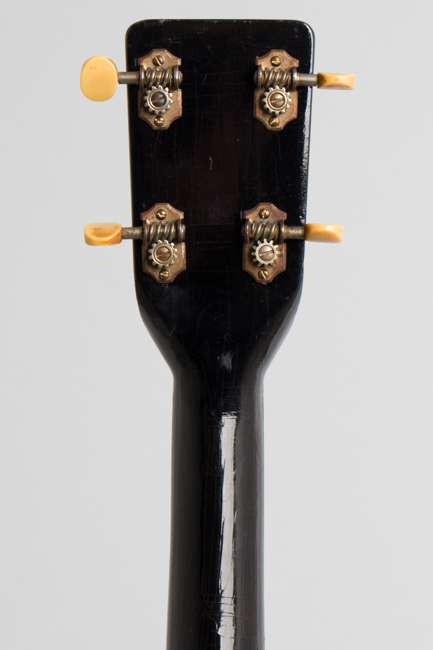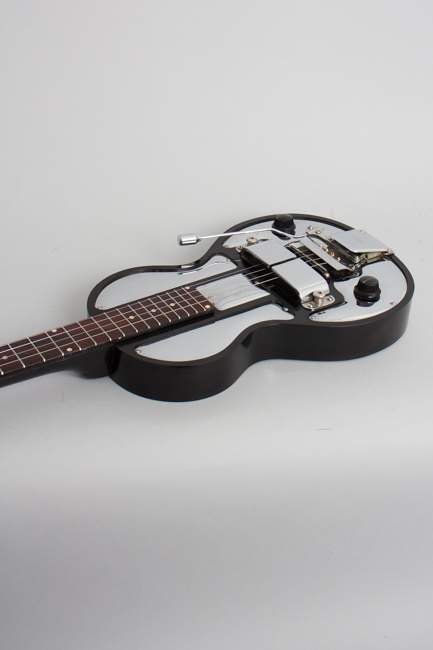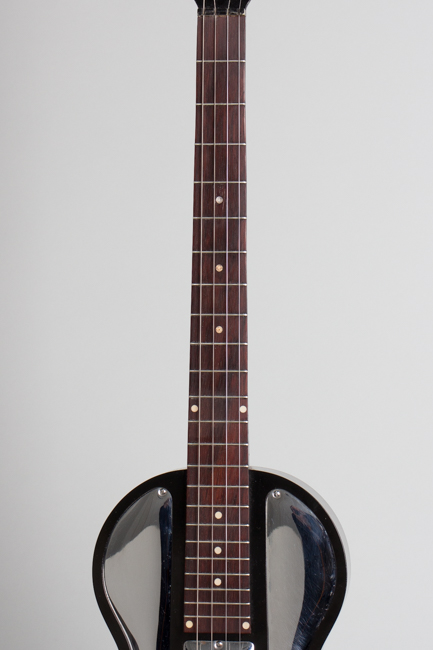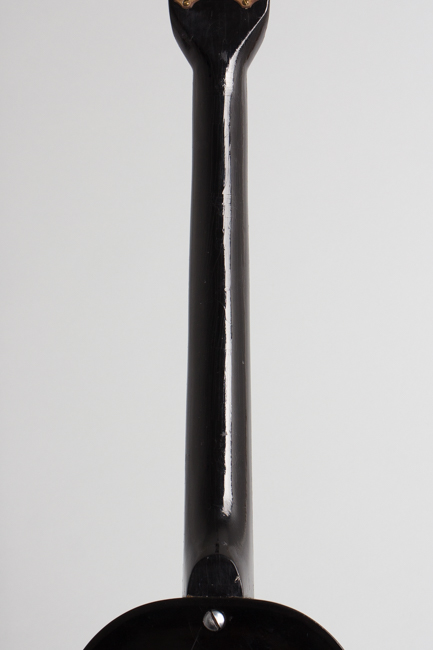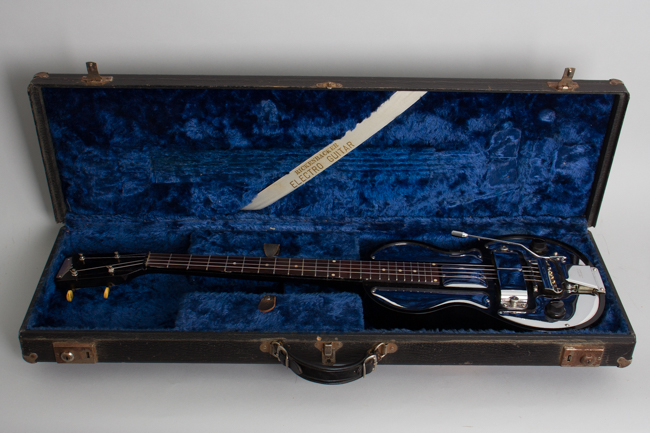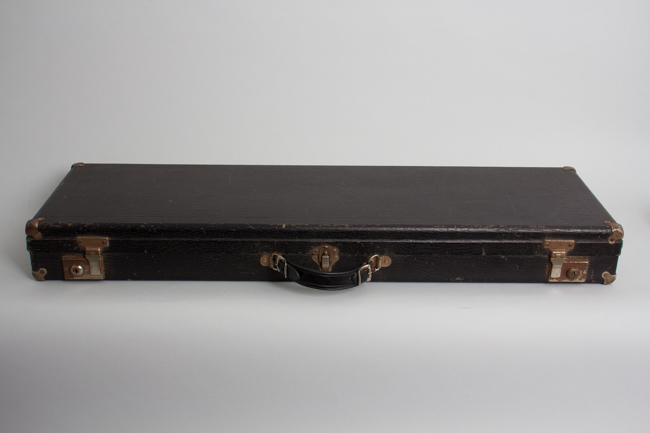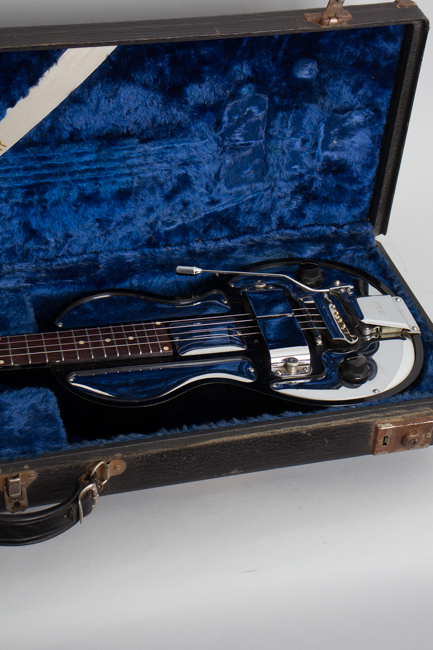Rickenbacker Electro Spanish Model B Tenor Solid Body Electric Guitar (1939)
This item has been sold.
Item # 9615
Prices subject to change without notice.
Rickenbacker Electro Spanish Model B Tenor Model Solid Body Electric Guitar (1939), made in Los Angeles, California, serial # C2122, polished Bakelite finish, black bakelite body, maple neck with rosewood fingerboard, original black hard shell case.
Here is an exceptionally rare and historically interesting American guitar, a most unusual variation of the first commercially important electric Spanish guitar. This is the four-string TENOR version of the Rickenbacker Electro-Spanish guitar. Introduced in 1935 at the same time as the famed Bakelite "Model B" Hawaiian Guitar, the Electro Spanish was not successful and in comparatively limited production for just a few years. Only a very small proportion were built up as tenors, making this the rarest of the rare!
While original Electro-Spanish six-string guitars were built with short-scale molded Bakelite necks (and frets!), only a the first few early tenors used this construction. We would guess the very slim Bakelite 4-strings necks soon proved unreliable, more subject to warpage than the beefier 6-string versions. This tenor features a conventional wooden neck with a rosewood fingerboard and actual metal frets, making for a huge improvement in playability over the solid Bakelite necks. Since the four-string neck is not an unusually short scale (for a tenor) and is equipped with a bone nut and metal frets, this ranks as easily the most player-friendly Bakelite Spanish instrument we have ever tried!
This guitar is the "middle" variation on the Bakelite Spanish theme, with the volume and tone knobs on opposite sides of the pickup and output jack still on the bass side. The molded body has five cavities covered by decorative metal plates and an aluminum bridge notched for four strings. The famed pre-war 1-1/2" wide horseshoe magnet pickup wraps over the strings and is the same as the regular six-string version. The mounting brackets are marked "Pat No. 2089171" on each side, dating it to after mid-1937.
The black-lacquered maple neck joins the body at the fourteenth fret, has twenty-three frets with inlaid ivoroid dot markers and is bolted in by two large screws. The original tuners are individual units with plastic buttons. The metal nameplate screwed to the headstock carries the old-style spelling "Rickenbacher Electro, Los Angeles" with the twin lightening bolt logo.
A particularly interesting feature of this guitar is the complete original Kauffman Vibrola tailpiece...these units today are often missing the arm or generally non-functional. Clayton Orr "Doc" Kauffman is one of the more unsung early electric guitar pioneers, and this invention -- the earliest vibrato tailpiece -- was his first major contribution to the American guitar. The Kaufmann Vibrola was designed to create Hawaiian-style vibrato effects for Spanish guitar players, and was on the market by 1933, with Epiphone in New York boasting exclusive distribution rights. Not surprisingly, the unit proved more effective on electric guitars than acoustic archtops with heavy strings, and by 1936 Rickenbacker had taken over as marketers of the device.
From that year onwards, Rickenbacker's Bakelite Spanish guitars usually came equipped with the unit, even though installing it involved milling off the body's molded integral string guide. Soon enough, Doc convinced Rickenbacker to market the motorized "Vibrola Spanish" guitar, which replaced the player's hand on the bar with an electric motor and flywheel in the body...but that's another story!
"Doc" Kauffman played his personal Vibrola Spanish guitar for some years afterwards, and interestingly the Fender Broadcaster -- designed not long after Kauffman's 1944-5 partnership with Leo Fender -- carries on several features of the Electro-Spanish guitar. The bolt-on neck (considered an easily replaceable part), the through-body stringing, and the bridge-mounted steel-guitar position pickup are all Electro-Spanish inspired features. The Electro-Spanish can be seen as the first progenitor of the California family of solid-body guitars to come.
This Tenor Electro-Spanish is far rarer than the Spanish six-string model or the common Hawaiian variation, which uses some of the same components but a different body and neck. Despite its obscurity, the astounding thing about this little guitar is how good it sounds. The heavy Bakelite body and horseshoe magnet pickup combine to produce an extremely powerful singing tone familiar to steel guitarists but virtually unique in a Spanish guitar. Add the wooden neck and fully wangable Kauffman unit and you have a very unique sonic package.
Although today perhaps primarily thought of as a museum-grade collector's piece, this Electro-Spanish Tenor Guitar is also a wonderful musical instrument, albeit an eccentric one. While the electric tenor guitar has never been particularly popular, this is probably the world's definitive solid-body tenor! This example includes the rare original deluxe oblong hard shell case with green plush lining.
Overall length is 32 3/8 in. (82.2 cm.), 9 1/4 in. (23.5 cm.) wide at lower bout, and 1 3/4 in. (4.4 cm.) in depth, measured at side of rim. Scale length is 22 5/8 in. (575 mm.). Width of nut is 1 5/16 in. (33 mm.).
This very rare tenor remains nicely original and in excellent condition overall. There is some fairly minor wear to the neck finish Mostly along the sides) and the plating. The neck has had a graphite rod added for straightness, and been very neatly refretted with period-appropriate wire. This rare oddball 4-string plays very well and sounds fantastic, just about the wildest four-string guitar we have ever offered! Excellent Condition.
Here is an exceptionally rare and historically interesting American guitar, a most unusual variation of the first commercially important electric Spanish guitar. This is the four-string TENOR version of the Rickenbacker Electro-Spanish guitar. Introduced in 1935 at the same time as the famed Bakelite "Model B" Hawaiian Guitar, the Electro Spanish was not successful and in comparatively limited production for just a few years. Only a very small proportion were built up as tenors, making this the rarest of the rare!
While original Electro-Spanish six-string guitars were built with short-scale molded Bakelite necks (and frets!), only a the first few early tenors used this construction. We would guess the very slim Bakelite 4-strings necks soon proved unreliable, more subject to warpage than the beefier 6-string versions. This tenor features a conventional wooden neck with a rosewood fingerboard and actual metal frets, making for a huge improvement in playability over the solid Bakelite necks. Since the four-string neck is not an unusually short scale (for a tenor) and is equipped with a bone nut and metal frets, this ranks as easily the most player-friendly Bakelite Spanish instrument we have ever tried!
This guitar is the "middle" variation on the Bakelite Spanish theme, with the volume and tone knobs on opposite sides of the pickup and output jack still on the bass side. The molded body has five cavities covered by decorative metal plates and an aluminum bridge notched for four strings. The famed pre-war 1-1/2" wide horseshoe magnet pickup wraps over the strings and is the same as the regular six-string version. The mounting brackets are marked "Pat No. 2089171" on each side, dating it to after mid-1937.
The black-lacquered maple neck joins the body at the fourteenth fret, has twenty-three frets with inlaid ivoroid dot markers and is bolted in by two large screws. The original tuners are individual units with plastic buttons. The metal nameplate screwed to the headstock carries the old-style spelling "Rickenbacher Electro, Los Angeles" with the twin lightening bolt logo.
A particularly interesting feature of this guitar is the complete original Kauffman Vibrola tailpiece...these units today are often missing the arm or generally non-functional. Clayton Orr "Doc" Kauffman is one of the more unsung early electric guitar pioneers, and this invention -- the earliest vibrato tailpiece -- was his first major contribution to the American guitar. The Kaufmann Vibrola was designed to create Hawaiian-style vibrato effects for Spanish guitar players, and was on the market by 1933, with Epiphone in New York boasting exclusive distribution rights. Not surprisingly, the unit proved more effective on electric guitars than acoustic archtops with heavy strings, and by 1936 Rickenbacker had taken over as marketers of the device.
From that year onwards, Rickenbacker's Bakelite Spanish guitars usually came equipped with the unit, even though installing it involved milling off the body's molded integral string guide. Soon enough, Doc convinced Rickenbacker to market the motorized "Vibrola Spanish" guitar, which replaced the player's hand on the bar with an electric motor and flywheel in the body...but that's another story!
"Doc" Kauffman played his personal Vibrola Spanish guitar for some years afterwards, and interestingly the Fender Broadcaster -- designed not long after Kauffman's 1944-5 partnership with Leo Fender -- carries on several features of the Electro-Spanish guitar. The bolt-on neck (considered an easily replaceable part), the through-body stringing, and the bridge-mounted steel-guitar position pickup are all Electro-Spanish inspired features. The Electro-Spanish can be seen as the first progenitor of the California family of solid-body guitars to come.
This Tenor Electro-Spanish is far rarer than the Spanish six-string model or the common Hawaiian variation, which uses some of the same components but a different body and neck. Despite its obscurity, the astounding thing about this little guitar is how good it sounds. The heavy Bakelite body and horseshoe magnet pickup combine to produce an extremely powerful singing tone familiar to steel guitarists but virtually unique in a Spanish guitar. Add the wooden neck and fully wangable Kauffman unit and you have a very unique sonic package.
Although today perhaps primarily thought of as a museum-grade collector's piece, this Electro-Spanish Tenor Guitar is also a wonderful musical instrument, albeit an eccentric one. While the electric tenor guitar has never been particularly popular, this is probably the world's definitive solid-body tenor! This example includes the rare original deluxe oblong hard shell case with green plush lining.
Overall length is 32 3/8 in. (82.2 cm.), 9 1/4 in. (23.5 cm.) wide at lower bout, and 1 3/4 in. (4.4 cm.) in depth, measured at side of rim. Scale length is 22 5/8 in. (575 mm.). Width of nut is 1 5/16 in. (33 mm.).
This very rare tenor remains nicely original and in excellent condition overall. There is some fairly minor wear to the neck finish Mostly along the sides) and the plating. The neck has had a graphite rod added for straightness, and been very neatly refretted with period-appropriate wire. This rare oddball 4-string plays very well and sounds fantastic, just about the wildest four-string guitar we have ever offered! Excellent Condition.
